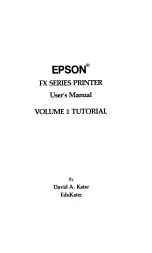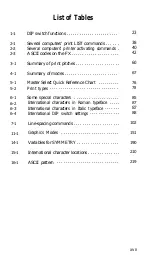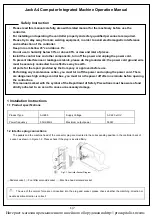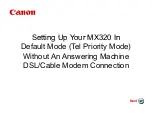
may use a version of BASIC other than Microsoft, you may need to
modify some of the programs in this manual before they will run.
Appendix F offers help, as do the next several paragraphs.
Methods for sending BASIC print and listing commands to the
screen and to the printer vary widely. We have used PRINT and LIST
as the commands for the screen display, and LPRINT and LLIST as
commands for the printer. You may have to change those to the form
used by your system.
If, for example, your system uses the
PR#1 and
PR#0 commands,
you will need to change all instances of PRINT in our programs. Since
we use PRINT to report progress to your screen and that command
does not affect the printing, the easiest modification is to delete such
PRINT statements. For example,
38 FOR D=1 TO 17: PRINT "ROW";D
would become:
39 FOR D=1 TO 17
because the only purpose of the PRINT statement is to display on the
screen information that is not absolutely essential to the program.
Any BASIC system automatically provides a carriage return (and
some BASIC
S
add a line feed) after every program line that includes a
PRINT or LPRINT command, whether that line prints text or not. To
prevent the carriage return, we have you place a semicolon at the end
of such program lines. You will see this technique throughout the
manual.
A few versions of BASIC use semicolons between any two control
codes that fall on one program line, as in:
LPRINT CHR$(27);CHR$(52)
If you use such a version of BASIC, you will need to add semicolons
as appropriate.
After the ESCape code-CHR$(27)-the FX always expects an-
other code. The second code tells the printer which mode to turn on or
off, and you may enter it in either of two formats. One format is like
the ESCape code-you use a number in parentheses after CHR$, such
as CHR$(l). The other format is shorter since it uses only an alphanu-
meric symbol within quotation marks, such as “E” or “@“. We usually
use the latter format.
iv
Summary of Contents for FX-80
Page 1: ......
Page 22: ......
Page 23: ......
Page 26: ......
Page 31: ...Figure 1 1 The FX 80 and FX 100 printers 14 ...
Page 32: ...Figure 1 2 Printer parts 1 5 ...
Page 38: ...Figure 1 8 DIP switch vent 21 ...
Page 42: ...Figure 1 11 Ribbon insertion 25 ...
Page 51: ...Figure 1 20 Paper thickness adjustment 34 ...
Page 85: ......
Page 92: ......
Page 95: ......
Page 97: ...80 ...
Page 109: ......
Page 117: ...Figure 7 3 Staggering STAIR STEPS 100 ...
Page 119: ...Table 7 1 Line spacing commands 102 ...
Page 129: ...112 ...
Page 147: ...130 ...
Page 181: ...Figure 12 4 Corner of the FX 80 design ...
Page 189: ...Figure 12 10 Most distinct version Figure 12 11 Reversed version 172 ...
Page 215: ...198 ...
Page 231: ...214 ...
Page 249: ......
Page 269: ......
Page 272: ...iv ...
Page 283: ......
Page 290: ......
Page 305: ...282 ...
Page 311: ...288 ...
Page 323: ...300 ...
Page 339: ......
Page 343: ...320 ...
Page 349: ...326 ...
Page 353: ...330 ...
Page 354: ...Schematic 331 ...





































